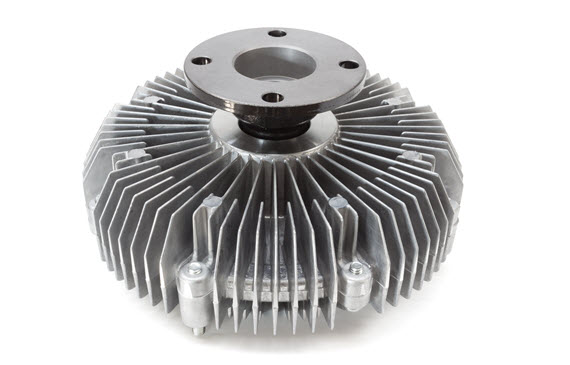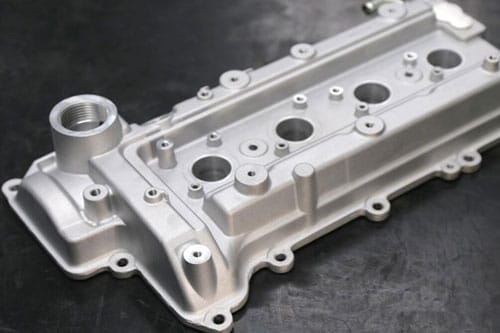Discovering the Benefits and Practical Uses of Aluminum Castings in Today's Market
Light weight aluminum spreadings have become progressively appropriate in numerous sectors because of their one-of-a-kind attributes. Their lightweight nature and resistance to rust make them suitable for requiring applications. In addition, the premium strength-to-weight ratio supplies considerable benefits in design and production. As sectors continue to explore their capacity, the full range of light weight aluminum castings' benefits and applications continues to be to be completely discovered. What exists ahead for this flexible product?
The Lightweight Benefit of Aluminum Castings
Numerous materials are utilized in production, aluminum castings stand out mostly due to their light-weight residential or commercial properties. This characteristic makes aluminum castings an appealing selection for numerous markets, specifically in aerospace and vehicle applications, where weight decrease is vital for improving fuel performance and efficiency. The light-weight nature of aluminum allows manufacturers to produce parts that are easier to deal with and install, ultimately reducing labor costs.
The capacity to create complicated forms without substantial weight penalties allows designers to innovate while keeping architectural stability. Light weight aluminum spreadings can properly change much heavier materials, leading to significant financial savings in delivery and functional costs. Their lightweight advantage additionally adds to improved product durability, as lighter components often bring about minimized deterioration on machinery. Generally, the lightweight homes of aluminum spreadings supply manufacturers with an one-upmanship, cultivating innovations in item layout and effectiveness throughout various markets.

Remarkable Corrosion Resistance
Light weight aluminum spreadings have an all-natural resistance to oxidation, which considerably enhances their longevity in numerous atmospheres. This intrinsic property not just adds to their sturdiness but also lines up with the lightweight benefit that light weight aluminum offers. Consequently, aluminum castings are increasingly identified for their outstanding rust resistance in various applications.
.jpg)
Naturally Resistant to Oxidation
Among the standout features of light weight aluminum spreadings is their outstanding rust resistance, which comes from a natural oxidation procedure. When subjected to air, light weight aluminum responds to develop a thin, safety layer of aluminum oxide. This layer acts as an obstacle versus further oxidation and protects the underlying steel from corrosive components such as dampness and salts. Unlike various other metals, this oxide layer is self-repairing; if damaged, it quickly reforms when revealed to air. This special residential property enhances the long life of aluminum castings in various atmospheres, making them perfect for applications in sectors such as aerospace, automotive, and marine. The all-natural resistance to oxidation significantly reduces upkeep costs and boosts the integrity of aluminum spreadings in requiring problems.
Light-weight Sturdiness Benefit
The lightweight nature of light weight aluminum spreadings adds greatly to their sturdiness, making them a beneficial selection in various markets. This phenomenal durability is largely credited to light weight aluminum's innate resistance to corrosion, which is improved additionally via anodizing and other surface therapies. Unlike several metals, light weight aluminum does not corrosion; rather, it develops a safety oxide layer that guards it from environmental damage. This property is especially beneficial in sectors such as automobile and aerospace, where weight decrease is essential without compromising toughness. Additionally, the long life of light weight aluminum spreadings minimizes upkeep prices and substitutes, providing financial benefits with time. Their light-weight resilience and corrosion resistance placement aluminum castings as a superior product for modern manufacturing applications.

Superior Strength-to-Weight Ratio
A remarkable quality of aluminum castings is their superior strength-to-weight ratio, which makes them very desirable in various applications. This intrinsic residential or commercial property permits aluminum castings to hold up against substantial stress and anxiety while remaining light-weight, a crucial consider industries such as aerospace, automotive, and manufacturing. Designers typically favor aluminum castings for components that need both toughness and reduced weight, improving gas effectiveness and efficiency.
The high strength-to-weight proportion also promotes the layout of detailed forms and frameworks, making light weight aluminum castings flexible for complicated applications. Additionally, the capacity to keep architectural honesty under challenging conditions warranties durability and integrity in products, from airplane structures to automotive components. This benefit adds to the growing fad of making use of light weight aluminum spreadings in ingenious layouts, eventually leading to boosted performance and performance throughout varied sectors. The premium strength-to-weight ratio of aluminum spreadings places them as an essential material in modern engineering and manufacturing.
Cost-Effectiveness in Manufacturing
Cost-effectiveness in aluminum casting manufacturing is primarily attained via lowered product waste and efficient manufacturing processes. By maximizing layouts and using advanced methods, suppliers can minimize excess product usage while maintaining high quality standards. This strategy not only lowers production expenses yet also adds to more sustainable methods within the sector.
Reduced Material Waste
Decreasing material waste in light weight aluminum casting processes greatly enhances production performance. By optimizing the design and manufacturing techniques, companies can reduce excess scrap and enhance resource utilization. This decrease in waste not only lowers product expenses yet likewise adds to a more sustainable manufacturing version. The capability to recycle light weight aluminum more assistances cost-effectiveness, permitting suppliers to redeem and reuse materials without compromising quality. As the industry significantly concentrates on sustainability, minimized product waste straightens with ecological goals while concurrently improving earnings. Ultimately, effective use of resources reinforces the competitive position of companies on the market, making aluminum spreadings a desirable choice in different applications. The critical technique to reducing waste mirrors a dedication to both environmental and financial obligation.
Efficient Production Processes
While standard manufacturing procedures can sustain significant prices, aluminum spreading provides an extra effective alternative that improves overall manufacturing profitability. This method minimizes material waste and enables precise control over the manufacturing procedure, bring about decreased labor and functional costs. The capacity to produce complex forms with fewer steps better improves production, contributing to much shorter preparations. In addition, aluminum's lightweight nature and superb thermal conductivity enable power financial savings during manufacturing more information and in the final application. By making use of contemporary spreading technologies, makers can attain higher throughput without sacrificing top quality. Consequently, aluminum spreading stands out as a cost-efficient service, making it an attractive choice for services intending to optimize their production processes in today's affordable market.
Versatility Across Industries
Light weight aluminum spreadings show impressive versatility across various industries, as they can be tailored to satisfy particular demands and applications. In the vehicle market, light weight aluminum castings are made use of in engine blocks, transmission real estates, and wheels, supplying light-weight yet sturdy options that boost fuel performance. The aerospace market additionally takes advantage of aluminum spreadings, using them in architectural elements and engine parts as a result of their strength-to-weight proportion.
In the durable goods industry, producers employ aluminum spreadings for products varying from pots and pans to furniture, providing both aesthetic appeal and functionality. The electronics sector utilizes light weight aluminum spreadings for housings and warm sinks, making certain effective thermal administration. In addition, the construction industry leverages aluminum castings for architectural blog here components and architectural elements, improving toughness and design versatility. This wide applicability highlights light weight aluminum spreadings as a crucial resource, satisfying the diverse needs of different markets while maintaining high performance and dependability.
Sustainability and Environmental Impact
As industries progressively focus on lasting methods, aluminum castings arise as an environment-friendly selection due to their recyclability and low environmental impact. Light weight aluminum is one of the most recycled materials internationally, with the ability to be repurposed numerous times without degradation of top quality. This particular greatly reduces the demand for raw products and power usage related to main aluminum production, which is energy-intensive.
Furthermore, aluminum spreadings add to light-weight designs, leading to fuel efficiency in transportation applications such as auto and aerospace industries. Their resilience and resistance to corrosion expand product lifespans, better decreasing waste and source use with time. Furthermore, lots of makers are adopting responsible sourcing and eco-friendly production methods, enhancing the sustainability of light weight aluminum spreading procedures. Overall, aluminum spreadings stand for a useful solution for services aiming to reduce their environmental influence while achieving efficiency and effectiveness.
Developments in Light Weight Aluminum Spreading Technologies
Current developments in aluminum casting technologies other have significantly enhanced the efficiency and top quality of production processes. Advancements such as 3D printing and advanced mold-making strategies have enabled producers to create intricate layouts with reduced material waste. This change not only improves the precision of actors parts but additionally shortens lead times, enabling quick prototyping and faster market access.
In addition, the incorporation of sophisticated computer system simulations help in forecasting potential flaws throughout casting, leading to higher-quality outcomes (Aluminum Foundry). Using lightweight alloys has actually additionally added to the development of stronger, extra resilient items, accommodating markets varying from vehicle to aerospace
Additionally, automated casting procedures have emerged, reducing human error and raising production speed. Collectively, these technologies are transforming the light weight aluminum casting landscape, driving better competition and sustainability in manufacturing. As markets remain to advance, these technologies will play an important role in meeting future needs for effectiveness and quality.
Often Asked Questions
Just How Do Aluminum Castings Compare to Various Other Metals in Terms of Thermal Conductivity?
Light weight aluminum castings exhibit superior thermal conductivity compared to numerous steels, such as steel and iron - Aluminum Foundry. Their lightweight nature and effective warmth circulation make them excellent for applications needing efficient thermal management in various industries
What Are the Typical Problems Discovered in Light Weight Aluminum Castings?
Common flaws in light weight aluminum spreadings consist of porosity, shrinkage, additions, and surface abnormalities. These issues commonly develop from incorrect air conditioning prices, insufficient mold and mildew design, or contaminations, impacting the general top quality and efficiency of the end product.
Can Light Weight Aluminum Castings Be Recycled, and Exactly how?
Aluminum castings can be reused efficiently. The process includes gathering, melting, and changing the aluminum, which decreases waste and saves sources. This reusing adds to sustainability while keeping the material's buildings for future use.
What Are the Regular Lead Times for Light Weight Aluminum Casting Production?
Typically, preparations for aluminum casting production variety from two to six weeks, depending upon variables such as complexity, tooling demands, and production quantity. Effectiveness can improve with recognized provider relationships and maximized production processes.
How Does the Surface Area Finish Affect Aluminum Casting Performance?
The surface finish significantly influences aluminum casting performance by influencing corrosion resistance, aesthetic top quality, and rubbing attributes. A smoother surface improves resilience and capability, while a rougher texture can improve adhesion for subsequent coatings or treatments.
Numerous materials are utilized in manufacturing, aluminum spreadings stand out largely due to their lightweight residential properties. When subjected to air, light weight aluminum reacts to form a thin, protective layer of light weight aluminum oxide. Cost-effectiveness in aluminum casting production is primarily accomplished via lowered product waste and effective manufacturing processes. Lowering material waste in aluminum spreading processes significantly improves production effectiveness. Eventually, effective usage of raw materials strengthens the competitive placement of services in the market, making light weight aluminum spreadings a favorable choice in numerous applications.